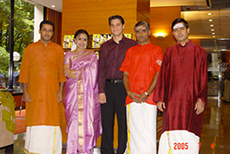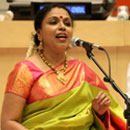 A Persian, Indian and Malian world harmonized within an over-arching structural concept, which permits everyone to express themselves according to the rules and discipline of their own artistic tradition. As ever, the rhythm of speech has been drummed out through the fingertips and the hollow of the hand as new encounters, combinations and ways of accompanying have been explored in the course of numerous experimental sessions, concerts and discussions, culminating in the studio event of July 2005! And brought to life at l’Abbaye de Royaumont.
A Persian, Indian and Malian world harmonized within an over-arching structural concept, which permits everyone to express themselves according to the rules and discipline of their own artistic tradition. As ever, the rhythm of speech has been drummed out through the fingertips and the hollow of the hand as new encounters, combinations and ways of accompanying have been explored in the course of numerous experimental sessions, concerts and discussions, culminating in the studio event of July 2005! And brought to life at l’Abbaye de Royaumont.
As the project got underway at Royaumont, the musicians worked with linguists. Kevyan Chemirani took, as the starting point, the metrical essence of each language in order to fit it to the singers’ breathing patterns. Rhythmical structures were revealed as motifs, tools, permitting easy passage from one musical culture to another. Basing itself on Indian and Persian verse, the work proceeded to a more complex stage in which Sudha Ragunathan searched for common modes of expression….modes not too far removed from each other, whether they are Carnatic, Persian or Malian!
Born out of the urge to change places in order to find common ground, The Rhythm of Speech is infused with the cultural traditions of each of the ten musicians who collaborated in bringing together languages with parallel vocal and rhythmic patterns, which might either clash or harmonize.
It was an unusual project, particularly for Sudha, our Shakti and fountain of vital energy. She is the initiator of the sacred music of Southern India and of the science of Carnatic music. In this Rhythm of Speech, Opus 2, she has put her voice at the disposal of a team and made available Hindu mantras, the formulas of her art, for others to listen to and utilize. “It was a bit nerve racking to start with because I wasn’t sure if my voice would marry with the rest of the project. I learned that the music you carry within yourself is that which we call ‘nada’ in relation to sound. I understood that sound has no barrier and even when you work with voices, you don’t know you can still manage to integrate with them. It has been a big discovery for me to find that sound can be fused into one unity.
Listening to Nahawa Doumbia, I realized that rhythm is a predominant element and that the melodic techniques are very close to certain ragas of our music; here two such ragas are blended with Nahawa’s singing. Working with the three musicians who accompany me in this project, felt at first like walking through a deep forest. The violinist Embar Kannan, Raman Ramakrishnan on the Jew’s harp and Skanda Subramanian Sundararajan on the mridangam, (two- way percussion instrument) do not have a strict uncompromising approach to classical music and they love to be challenged. I think they went together brilliantly. This project has succeeded because it has spiritual dimension to it. During the course of this experience, I’ve had some very curious moments, as if ‘called’ by sound, especially when singing in the very uppermost registers. When I sang with Nahawa Doumbia and Ali Reza Ghorbani, our three voices melted through the sound into one. I lost track of the notes or the beat I just sang, as if propelled by cosmic energy and pulsation.”
Comments are closed.



.png)
 Sudha Ragunathan is the only carnatic musician after Bharat Ratna M. S. Subbulakshmi to have sung in the United Nations.
Sudha Ragunathan is the only carnatic musician after Bharat Ratna M. S. Subbulakshmi to have sung in the United Nations.